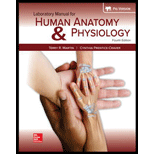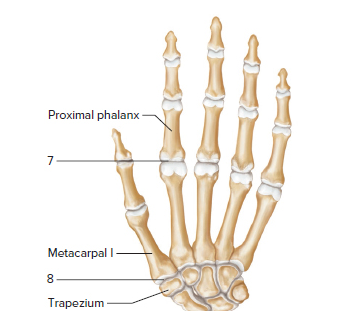
Laboratory Manual For Human Anatomy & Physiology
4th Edition
ISBN: 9781260159363
Author: Martin, Terry R., Prentice-craver, Cynthia
Publisher: McGraw-Hill Publishing Co.
expand_more
expand_more
format_list_bulleted
Concept explainers
Textbook Question
Chapter 19, Problem 2.8A
Identify the types of structural and functional joints numbered in figure 19.7.
Structural Classification
Functional Classification
8. ___________________
_______________________

Expert Solution & Answer
Want to see the full answer?
Check out a sample textbook solution
Students have asked these similar questions
Green Algae, as a group, is actually paraphyletic with one subgroup more closely related to higher plants than the other. Which of the following green algae groups is more closely related to higher plants:
a. Charophyceans
b. Chlorophyceans
c. Rhodophyta
d. Xanthophyceans
A single-celled green algal genus that is motile with 2 flagella, has a cup shaped chloroplast, and an eyespot:
a. Volvox
b. Chlamydomonas
c. Euglena
d. Codium
A[n] ___ is produced by members of the Myxomycota when there is a lack of moisture.
a. plasmodiocarp
b. aethalium
c. sclerotium
d. plasmodium
Chapter 19 Solutions
Laboratory Manual For Human Anatomy & Physiology
Ch. 19 - Pre-Lab Questions Select the correct answer for...Ch. 19 - Pre-Lab Questions Select the correct answer for...Ch. 19 - Pre-Lab Questions Select the correct answer for...Ch. 19 - Pre-Lab Questions Select the correct answer for...Ch. 19 - Pre-Lab Questions Select the correct answer for...Ch. 19 - Pre-Lab Questions Select the correct answer for...Ch. 19 - Pre-Lab Questions Select the correct answer for...Ch. 19 - Pre-Lab Questions Select the correct answer for...Ch. 19 - Match the terms in column A with the descriptions...Ch. 19 - Identify the types of structural and functional...
Ch. 19 - Identify the types of structural and functional...Ch. 19 - Identify the types of structural and functional...Ch. 19 - Identify the types of structural and functional...Ch. 19 - Identify the types of structural and functional...Ch. 19 - Identify the types of structural and functional...Ch. 19 - Identify the types of structural and functional...Ch. 19 - Identify the types of structural and functional...Ch. 19 - Identify the types of structural and functional...Ch. 19 - Identify the types of structural and functional...Ch. 19 - Match the types of synovial joints in column A...Ch. 19 - Complete the missing components of the following...Ch. 19 - Identify the types of joint movements numbered in...Ch. 19 - Identify the types of joint movements numbered in...Ch. 19 - Identify the types of joint movements numbered in...Ch. 19 - Identify the types of joint movements numbered in...Ch. 19 - Identify the types of joint movements numbered in...Ch. 19 - Identify the types of joint movements numbered in...Ch. 19 - Identify the types of joint movements numbered in...Ch. 19 - Identify the types of joint movements numbered in...Ch. 19 - Identify the types of joint movements numbered in...Ch. 19 - Identify the types of joint movements numbered in...Ch. 19 - Identify the types of joint movements numbered in...Ch. 19 - Identify the types of joint movements numbered in...Ch. 19 - Identify the types of joint movements numbered in...Ch. 19 - Identify the types of joint movements numbered in...Ch. 19 - Identify the types of joint movements numbered in...Ch. 19 - Identify the types of joint movements numbered in...Ch. 19 - Identify the types of joint movements numbered in...Ch. 19 - Identify the types of joint movements numbered in...Ch. 19 - Identify the types of joint movements numbered in...Ch. 19 - Identify the types of joint movements numbered in...Ch. 19 - Identify the types of joint movements numbered in...Ch. 19 - Identify the types of joint movements numbered in...Ch. 19 - Identify the types of joint movements numbered in...Ch. 19 - Identify the types of joint movements numbered in...Ch. 19 - Identify the types of joint movements numbered in...Ch. 19 - Identify the types of joint movements numbered in...Ch. 19 - Identify the types of joint movements numbered in...Ch. 19 - Identify the types of joint movements numbered in...
Additional Science Textbook Solutions
Find more solutions based on key concepts
Describe the role and impact of microbes on the earth.
Microbiology Fundamentals: A Clinical Approach
Why do scientists think that all forms of life on earth have a common origin?
Genetics: From Genes to Genomes
Gregor Mendel never saw a gene, yet he concluded that some inherited factors were responsible for the patterns ...
Campbell Essential Biology (7th Edition)
To test your knowledge, discuss the following topics with a study partner or in writing ideally from memory. Th...
HUMAN ANATOMY
Q1. What is the empirical formula of a compound with the molecular formula
Chemistry: A Molecular Approach (4th Edition)
Knowledge Booster
Learn more about
Need a deep-dive on the concept behind this application? Look no further. Learn more about this topic, biology and related others by exploring similar questions and additional content below.Similar questions
- Which of the following is not true about the life-cycle of Fucus. a. 8 eggs per oogonium b. 64 sperm per antheridium c. eggs are flagellated d. sperm are flagellatedarrow_forwardGreen Algae, as a group, is actually paraphyletic with one subgroup more closely related to higher plants than the other. Which of the following green algae groups is more closely related to higher plants: a. Charophyceans b. Chlorophyceans c. Rhodophyta d. Xanthophyceansarrow_forwardCertain toxic terpenoids in this group is thought to deter herbivory but may also have some anti-tumor activity? a. green algae b. brown algae c. red algae d. golden algae e. none of thesearrow_forward
- In the cellular slime molds, the most common phase is: a. plasmodium b. pseudoplasmodial c. single cells as myxamoebae d. moundingarrow_forwardWhich of the following descriptive terms does not describe Hydrodictyon? a. colonial b. nonmotile c. 1 large reticulated chloroplast in each cell d. all of these describe Hydrodictyonarrow_forwardWhich of the following does not apply to Chara? a. "stoneworts" b. isogamous c. calcified walls d. apical growth with an axis and branchesarrow_forward
arrow_back_ios
SEE MORE QUESTIONS
arrow_forward_ios
Recommended textbooks for you
 Fundamentals of Sectional Anatomy: An Imaging App...BiologyISBN:9781133960867Author:Denise L. LazoPublisher:Cengage Learning
Fundamentals of Sectional Anatomy: An Imaging App...BiologyISBN:9781133960867Author:Denise L. LazoPublisher:Cengage Learning



Fundamentals of Sectional Anatomy: An Imaging App...
Biology
ISBN:9781133960867
Author:Denise L. Lazo
Publisher:Cengage Learning



Chapter 7 - Human Movement Science; Author: Dr. Jeff Williams;https://www.youtube.com/watch?v=LlqElkn4PA4;License: Standard youtube license